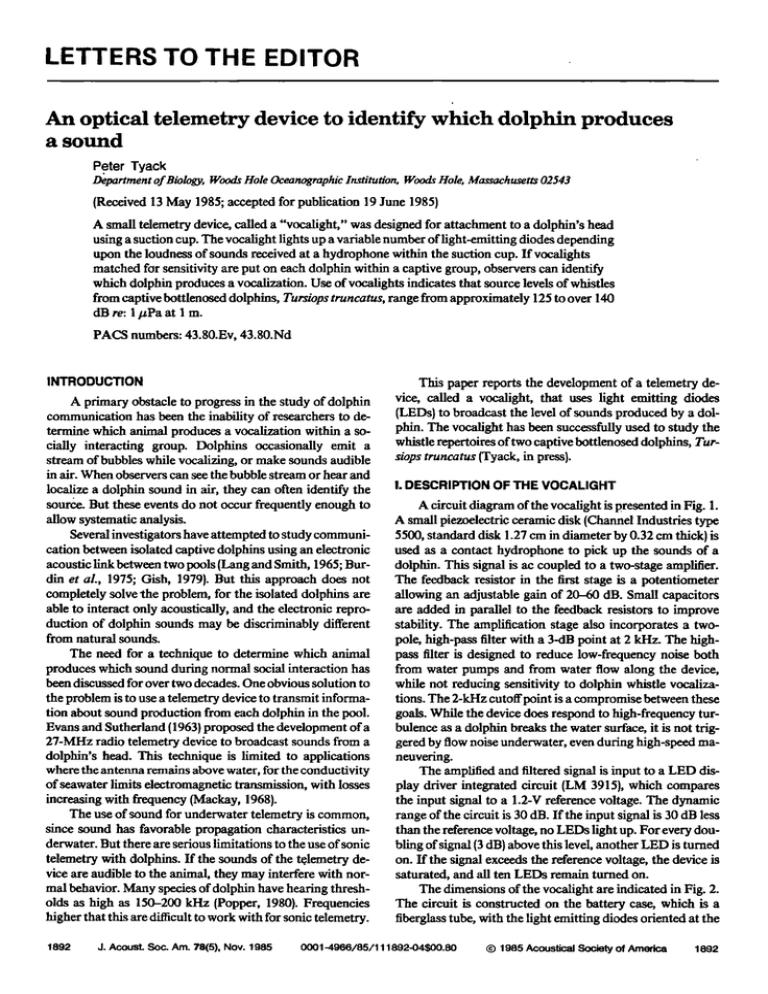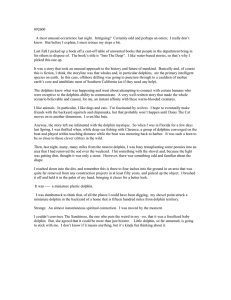(1985). "An optical telemetry device to identify which dolphin
advertisement

LETTERS TO THE EDITOR
An optical telemetry device to identify which dolphin produces
a sound
Peter Tyack
Departmentof Biology,WoodsHole Oceanographic
Institution,WoodsHole, Massachusetts
02545
(Received13 May 1985;accepted
for publication19June1985)
A smalltelemetrydevice,calleda "vocalight,"wasdesigned
for attachment
to a dolphin'shead
usinga suctioncup.Thevocalightlightsupa variablenumberof light-emitting
diodesdepending
upontheloudness
of soundsreceivedat a hydrophone
withinthe suctioncup.If vocalights
matchedfor sensitivity
areput on eachdolphinwithina captivegroup,observers
canidentify
whichdolphinproducesa vocali?ation.Useof vocalightsindicatesthat sourcelevelsof whistles
fromcaptivebottlenosed
dolphins,Tursiops
truncatus,
rangefromapproximately
125to over140
dBre: 1pPa at 1 m.
PACS numbers:43.80.Ev, 43.80.Nd
INTRODUCTION
A primaryobstacleto progress
in the studyof dolphin
communicationhasbeenthe inability of researchersto determinewhich animal producesa vocalizationwithin a socially interacting group. Dolphins occasionallyemit a
streamof bubbleswhilevocalizing,or makesoundsaudible
This paperreportsthe development
of a telemetrydevice, called a vocalight,that useslight emitting diodes
(LEDs) to broadcastthe levelof soundsproducedby a dolphin.The vocalighthasbeensuccessfully
usedto studythe
whistlerepertoires
of twocaptivebottlenosed
dolphins,Tursiopstruncatus(Tyack,in press}.
in air. When observers can see the bubble stream or hear and
localizea dolphinsoundin air, they can oftenidentifythe
I. DESCRIPTION
souffle.
Butthese
events
donotoccurfrequently
enough
to
A circuitdiagramof thevoealightispresented
in Fig. 1.
A smallpiezoelectric
ceramicdisk(ChannelIndustriestype
5500,standarddisk1.27cmin diameterby0.32cm thick)is
usedas a contacthydrophoneto pick up the soundsof a
dolphin.This signalis ae coupledto a two-stageamplifier.
The feedbackresistorin the first stageis a potentiometer
allowingan adjustablegainof 20-60 dB. Smallcapacitors
are addedin parallelto the feedbackresistorsto improve
stability.The amplificationstagealsoincorporates
a twopole,high-pass
filterwith a 3-dBpointat 2 kHz. The highpassfilter is designed
to reducelow-frequency
noiseboth
from water pumpsand from water flow alongthe device,
while not reducingsensitivityto dolphinwhistlevocalizations.The 2-kHz cutoffpointis a compromise
betweenthese
goals.While the devicedoesrespondto high-frequency
turbulenceasa dolphinbreaksthe water surface,it is not triggeredby flownoiseunderwater,evenduringhigh-speed
ma-
allow systematic
analysis.
Severalinvestigators
haveattemptedto studycommunicationbetweenisolatedcaptivedolphinsusingan electronic
acousticlink betweentwopools(LangandSmith,1965;Burdin et al., 1975;Gish, 1979}.But this approachdoesnot
completelysolvethe problem,for the isolateddolphinsare
ableto interactonlyacoustically,
and the electronicreproductionof dolphinsoundsmay be discriminablydifferent
from natural sounds.
The needfor a techniqueto determinewhich animal
produces
whichsoundduringnormalsocialinteractionhas
been discussed for over two decades. One obvious solution to
theproblemisto usea telemetrydeviceto transmitinformation aboutsoundproductionfrom eachdolphinin the pool.
EvansandSutherland(1963)proposedthedevelopment
of a
27-MHz radio telemetrydeviceto broadcastsoundsfrom a
dolphin'shead. This techniqueis limited to applications
wherethe antennaremainsabovewater, for the conductivity
of seawaterlimitselectromagnetic
transmission,
with losses
increasing
withfrequency
(Mackay,1968).
The useof soundfor underwatertelemetryis common,
sincesoundhasfavorablepropagationcharacteristics
underwater. But there are serious limitations to the use of sonic
OF THE VOCALIGHT
neuvering.
The amplifiedandfilteredsignalis input to a LED display driver integratedcircuit(LM 3915),which compares
the input signalto a 1.2-V referencevoltage.The dynamic
rangeof thecircuitis 30 dB. If theinputsignalis 30 dB less
thanthereference
voltage,noLEDs lightup.For everydoublingof signal(3 dB)abovethislevel,anotherLED isturned
on. If the signalexceeds
the referencevoltage,the deviceis
telemetrywith dolphins.If the soundsof the telemetrydesaturated,and all ten LEDs remain turned on.
viceareaudibleto the animal,theymay interferewith norrealbehavior.Many spedesof dolphinhavehearingthreshThe dimensions
of the vocalightare indicatedin Fig. 2.
oldsas high as 150-200kHz (Popper,1980).Frequencies The circuit is constructedon the battery ease,which is a
higherthatthisaredifficulttoworkwithforsonictelemetry. fiberglass
tube,with the light emittingdiodesorientedat the
1892
J. Acoust.Soc.Am.78(5), Nov.1985
0001-4966/85/111892-04500.80
¸ 1985 Acoustical
Societyof America
1892
lOOK
100
100
LM•5915
pZTL
tllOOKTL••..•
v.
MODE"9"--I
•N "7":-i
1K:
0.1pf
•
FIG. I. Schematicdiagram of
voca[ightcixcuit.
Jl-I""'
REFou
T""':'-'
"5"L'--I
.3.1_
I
,o.,"lJRœFA0d
b..o
v-
ß
III *
4001
topof thetubeandthecontacthydrophone
at thebottom. whichthe suctioncupis attached.The batterycase/ssealed
Oncethe circuitis constructed
andtested,it is pottedin withanendcapmachinedoutof acrylicplasticwitha rubber
epoxy(HysolRE 2039resinandHD 3469hardener)
us/ng O-ring.Dur•tcellTR-177mercurybatteries(9.8V) areused
anepoxy
mold.Thecircuit/sthenattached
toa suction
cup to powerthevocalight.
{ArianticIndia suctioncuptype472, 5.08cm in diameter,
Figure3 showsa Bodeplotof thefrequency
response
of
madefromcompound
13312)usingthesameepoxy.In this a vocalight.Thesemeasurements
were made at least2 m
step,the hydrophone
element/ssealedwith a thin film of
from the nearestreflectingsurfacein an acoustictestpool.
epoxyat the baseof the suctioncup.The contacthydrophone
isbacked
byclosed
cellfoamtoreduce
thestrength
of
signals
comingfromanyd/rectionotherthanthesurface
on
Calibration tone bursts of 1.5-ms duration were used to al-
TOP VIE W
low measurement
of soundlevelsunaffected
by echoes.
Tone
burstswerebroadcastwith a poweramplifier,impedance
matchingtransformer,
anda USED F-40 transducer.
Sound
levelsweremeasured
with a calibratedLC-10 hydrophone
l
m from the soundsource.The minimumfrequencythat
could be tested with these short tone bursts was 2 kHz. At
frequencies
of greaterthan25 kHz, the outputof thesound
projectorshowedamplitudemodulation,
presumably
dueto
nonlinearresponse
of the transformerat thesefrequencies.
Th/s determinedthe upperlitnit of calibration.
/EMBER SUCTION CUP
•'
EPOXy4
-.......... '%
'-!
....
•--. ....
r-.-- .; •
13•-
SIDE
VIEW
•'
.
.l•..
'• ' .-': '.'.BATTERY
CASE
i
i
I
18
YDEOPH•NE
ELEMENT
SUCTION
CUP-"•
CAP
L .
Icm
'FIG. 2. SC,dc
drawingof thevoc•ght.
1893
12512•
[__.
/
135,
J. Acoust. Soc. Am., VoL 78, No. 5, November 1985
I:I•Y
i
20
/kHz)
FIG. 3. Bodcplotindicatingthefrequency
rcsponse
of thevocalight.Frequencyresponse
wasmeasuredin an acoustictesttank using1.5-mstone
burstsanda calibratcdhydrophoneI m from thesource.The thresholdon
theplotindicates
thesoundlevelrequired
tolightuphalfoftheIEDs ona
vocalightattachedto thesoundprojector.
Letters to the Editor
1893
The vocalightwasattachedto thefiat faceof thesound
projectorwith the suctioncup.This placedthe vocalight
hydrophone
approximately
2 cm fromth6edgeof theactive
element of the sound source and 7 cm from its center. At
eachtestfrequency,
thesoundlevelwasadjustedto light up
approximatelyhalf of the LEDs. The thresholdof response
of thevocalightwasjudgedby eye.Visualestimationof this
thresholdlevelwasthe leastprecisestepin the calibration,
because the short duration of the tone bursts made it difficult
to estimateexactlyhow manyLEDs lit up.
II. USE OF THE VOCALIGHT
WITH DOLPHINS
Captivebottlenosed
dolphins,Tursiopstruncatus,were
trainedto wearvocalightsat Sealand,an aquariumin Brewster,MA on CapeCod, and at the New EnglandAquarium
in Boston.Vocalightswereplacedon the dolphins'melons
severalcentimeters
anteriorto theblowhole.To preventskin
irritation,thesuctioncuponeachvoealightwascoatedwith
a lubricantbeforeuseandwasremovedeveryhalfhouror so
forrepositioning.
Whilea dolphi
ncouldshake
theroealight
off by rapid sidewaysmotion of the head, the vocalights
usuallyremainedin positionduring normal activities,ineludingbreachesand chases.A suitablerangeof amplifier
gainfor thisdevicewasdetermined
by testswith thecaptive
dolphins.The optimalamplifiergainwasapproximately50
dB.
The vocalightswere usedto definethe whistlerepertoiresof the two Tursiopsheld at Sealand(for a detaileddescriptionof the resultsof thisstudy,seeTyack,in press).In
order to determinewhich of the two dolphinsproduceda
whistle,the vocalightswereadjustedto haveidenticalsensitivity. To helpidentifythedolphins,redLEDs wereusedfor
onevocalight,and greenfor the other.Dolphin soundswere
pickedupbya hydrophone
in thepoolandbroadcast
in air to
observers
aroundthe pool,who carefullywaW.
hedthe vocalightnearestthem.If bothdolphinswerenearby,oneobserver could sometimesfollow both devices,but severalobserversat differentlocationswereusuallyrequiredto keepboth
devicesunder observation.When a whistlewas produced,
the observer called out an estimate of the number and color
III. DISCUSSION
Sincethe vocalightis calibratedfor soundlevel,it may
be usedto estimatethe sourcelevelof whistlesfrom captive
Tursiops,
with severalcaveats.For a roughestimate,let us
assumethat the problemsof nearfieldinterferenceeffects
andsounddirectionalitywouldnot leadto significantdifferencesin measured
levels.Figure3 showsthat for the fre-
quencyrangeof 5-12 kHz, soundlevelsof approximately
125dB re: I pPa at 1 m fromthe soundprojectorwererequiredto light up half of the LEDs. Sincethereis a 15-dB
increasein thresholdfrom lightingup half of the LEDs to
lightingall of them, the thresholdfor lightingall LEDs
wouldbe approximately140dB. No whistlesaudibleto us
were so faint that no LEDS lit up, which would correspond
to a thresholdof approximately110 dB. Almost all of the
whistleslit up at leasthalf of the LEDs, corresponding
to a
thresholdof 125 dB. Many whistlessaturatedthe device,
lightingupall LEDs.Thesewhistles
hadlevelsofat least140
clB,but the max/mum levelsare unknown.
Thereare few reportson the sourcelevelsof Tu•siops
whistles.FishandTurl {1976)measured
themaximumlevels
at differentfrequencies
of a sampleof whistlesfroma group
of approximatelyten wild Tursiops.Maximum levelswere
measured
byusinga peakholdmodeona real-timespectrum
analyzer.Theselevelsrangedfrom 150-173dB re: I pPa at 1
m, whichisconsistent
with theresultreportedin thispaper
thatwhistles
exceeded
levelsof 140dB.Useof thevocalight
showsthat Tursiopscan modifythe levelsof their whisfies
overa largedynamicrange.This pointis alsomadeby WatkinsandScbevill{1974),whomeasured
sourcelevelsof whistiesfromwild spinnerdolphins,Stenella1ongirostris,
varying
from 109-125dB re: l/•Pa at 1 m.
While the vocalighthasonlybeenusedwith captivedolphins,it mightbe usedwith wild dolphinsin an application
whereobservers
couldstayneara few individualsandwhere
watervisibilitywasgood.The mostseriousproblemwould
beattachmentof thedevice.Attachmentwouldbesimplest
if onecouldcatchandrestraina dolphin,attachthe device
byhand,andthenfreetheanimal.It mightalsobepossible
to
attachthe deviceto dolphinsnear a boat, usingpolesor a
smallprojectilelike the suctioncup-tippedarrowsusedby
Goodyear{1981)to attachsuctioncupsto baleenwhales.
of the LEDS that lit up. If a whistlewasheardbut observers
did not seeany LEDS light up, they calledout that noneof
the colorof the LEDs on that devicelit up. Ifthey couldnot
see any devicesclearly, they remainedsilent. These comACKNOWLEDGMENTS
mentswererecordedwith a microphoneon a secondchannel
of the same tape that recordedthe underwaterdolphin
Thanks to Ronald Larkin, Francis Carey, Frederick
sounds.
Hess,Wfiliam Watkins,G. Richard Harbison,and Richard
It was seldom difficult to associate observers' comments
Kochlet for advice, engineeringassistance,and loans of
with one whistle,unlessboth dolphinsproducedsimulta- equipmentand spaceduringdevelopment
of the vocalight.
neoussounds.While the loudnessof the whistles varied, the
Testingof the vocalightwasperformedat the New England
30-dBrangeof the vocalightwasusuallysufficientto identiAquariumand at Sealand,.anaquariumin Brewster,MA.
fy whichanimalhadwhistled.The vocalightswereadjusted Thanksto GeorgeKing,thedirectorof Sealand,Dick Gage,
to turn on severalLEDs evenfor relatively faint whistles.
Janet Hester, Jack Pearson, John Prescott, Susan Sinclak,
and Keith Wilson. Thanks to Charles I. M_alme of Bolt BerObserversneverreportedthat neitherdevicelit up whena
whistlewasheard.But occasionally
whenveryloudwhistles anekandNewmanInc. for helpin calibratingthe vocalight.
wereheard,and both dolphinswereseparated
by only apThanks to Francis Carey, Karen Moore, William Schevill,
proximatelyI m,bothdevices
lit upfully,makingit impossi- and William Watkinsfor reviewingthe manuscript.This
ble to identifywhichanimalproducedthe whistle.
researchwas performedwith financialassistance
from a
1894
J. Acoust. Soc. Am., Vol. 78, No. 5, November 1985
Letters to the Editor
1894
W. H. O. I. PostdoctoralScholarAward and N. I. H. Post-
truncatusMontagu),"Ph.D. thesis,Universityof Californiaat Santa
Cruz,availablefromUniversityMicrofilms,Ann Arbor,MI.
doctoralFellowship
$-F32-NS07206.
This is contribution Goodyear,
I. (19•1)."Remoratageffects
thefirstradiotrackingof anAtnumber5941fromtheWoodsHoleOceanographic
Institulantichumpback,"in FourthBiennialConference
on theBiologyof Mation.
rineMammals,Abstracts,
p. 46.
Lang, T. (3., and Smith, H. A. P. {1965)."Communicationbetweendolphinsin separatetanksby way of an electronicacoustic!ink," Science
150, 1839-1844.
Burdin,
V. I., Re•nil•;
A.M., Skomyakov,
V. M.,andChupakov,
A. O.
(197S).
"Communication
signals
oftheBlack
Seabottlena6ed
dolphin," Mackay,R. S.(1968).Bio-medical
Telemetry
(Wiley,NewYork),p. 359.
SOy.Phys.Acoust.20, 314-318.
Evans,
W. E.,andSutherland,
W. W.(1963).
"Potential
fortelemetry
in
studies
ofaquatic
animal
communication,"
inBio-telemetry,
edited
byL.
E. Slater(Pergamon,
Oxford),
pp.217-224.
Fish,
J.F.,andTurl,C.W.(1976).
"Acoustic
source
levels
offourspecies
of
small
whales,"
Naval
Undersea
Center
Report
Number
NUCTP547(14
Gish,$. L. (1979)."A
quantitative
description
of two-way
acoustic
communication
between
captive
Atlantic
bottlenosed
dolphins
(Tursiops
Popper,A. N. (19•0)."Soundemission
anddetection
by delphinids,"
in
Cetacean
Behavior.
Mechanisms
andFunctions,
editedbyL. M. Herman
(Wiley,New York),Chap.1,pp. 1-52.
Tyaek,P. (inpress).
"Whistlerepertoires
of twobottlenosed
dolphins,
Turslopstruncatus:Mimicry of signaturewhistles?,"
submittedto Behav.
Ecol. Sociobiol.
Watkins,
W. A., andSchevili,
W. E. (1974)."Listening
toHawaiian
spinner
porpoises,
$tenellacf.1ongirostris,
witha three-dimensional
hydrophone
array," I. Mammal. 55, 319-328.
Level effects in complex stimulus discrimination
ChristopherW. Turnerand AnthonyT. Cacace
Communication
Sciences
andDisorders,
Syracuse
University,
805SouthCrouse
Avenue,
Syracuse,
New York
13210
(Received
23 July1984;accepted
for publication
23 July1985)
Thedependence
of spectral-shape
discriminations
uponpresentation
levelwasstudied
using
stimuliconsisting
of a bandpass
noiseanda lessintense
puretone.Thelevelof thenoisebandwas
heldconstant
( + 10dB)relativeto thelevelof thetone,andtheminimumchange
in theintensity
of thetonewasmeasured
across
a rangeof presentation
levels.The resultsdemonstrated
that,for
tonalfrequencies
locatedneartheupperedgeof thenoiseband,subject's
optimalperformance
occurredat intermediate
presentation
levelsandbecameconsiderably
poorerat highlevels.This
resultisin accordance
with upwardspreadof maskingandemphasizes
that presentation
levelis
animportantparameterto consider
whenmeasuring
discriminations
of complexspectralshapes.
PACS numbers:43.66.Fe, 43.66.Dc
INTRODUCTION
The abilityof subjects
to discriminate
betweencomplex
spectralshapeshascommonlybeenstudiedby determining
thedifference
limenfor an incrementalchangein the stimulus.Usingsuchtasks,TurnerandVan Tasell(1984)andMasonet al. (1984)notedthat subject'sperformance
wasdecreasedat high presentationlevelsin tasksrequiringthe
discrimination
of smallchanges
in the levelwithinspecific
frequency
regionsof a complexstimulus.In a studyusing
speechlike
stimuli,Danaheretal. (1973)foundthatdiscriminationof frequency
changes
ofa second-formant
component
frequency
patternseenin spreadof maskingstudies,
or in
otherterms,thebroadening
of auditoryexcitationpatterns
with increasinglevel.
Thepresent
reportdescribes
theeffectupondiscriminationofa singlestimulus
component
resulting
fromintercom-
ponent
masking,
asa function
ofpresentation
level.Thedifference limen for intensity of a single pure tone was
measured
bothforthetonein isolationandin thepresence
of
a higher-intensity
narrow-band
masking
noise.
Thefrequencydistance
between
toneandnoisewasvariedacross
conditions in order to determinethe effectsof intercomponent
was in some cases reduced when a first formant was added to
masking
asa functionof frequency
andlevelof thestimulus
the stimulus,particularlyat high presentationlevels.They
components.
suggestedthat intercomponentmaskingmay affect the dis-
criminationof spectralshapes.Thesepreviousstudiesdemonstratedthat performance
in the discrimination
of a given
complexspectralshapemaybedependent
uponpresentation
level.Thisdependence
wouldbeexpectedto followfromthe
1895
I. METHODS
A two-interval, two-alternative forced choice task
(2AFC) was usedto measurediscriminationperformance.
The subject'staskwasto indicate,via response
buttons,the
J. Acoust.Soc. Am. 78(5), Nov. 1985; 0001-4966/85/111895-03500.80; ¸ 1985 Acoust.Soc. Am.; Lettersto the Editor
1895



